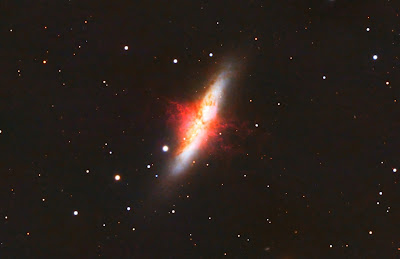The new pier pads have been completed and the telescope mount re-assembled. I was able to spend a few hours recalibrating and realigning the scope this past Monday. First new photos will be attempted this weekend.
Friday, June 24, 2022
Saturday, June 18, 2022
New Pier Pads Installed
As reported in my previous blog, I have been having problems with moles digging in under my telescope pier. I finally found the time to make the repairs.
I decided to do the construction in the same location as the original mount to keep from having to redo the Lat/Lon data used in all my software. Each footing was dug in about a foot into the ground at each tripod leg location.
Once the holes were dug, I removed the layer of grass completely around the pads.
Then, paver base was poured into each hole and tamped down. I ended up using sufficient base to go to a depth of 10"-12"; a bit overkill, but I had the material.
Next, paver sand was placed at a depth of 1".
The plan was to use 12"x12"x1.5" paver stone to support the tripod pier. I needed three at the southern point and two at the other locations to handle the ground grade. I was concerned that the stones would slide on each other, so I cemented them together with stone mortar. Paver sand was tamped in around each set of stones.
Finally, ground cover to prevent grass and weeds from growing and ornamental marble gravel was spread around the entire area.
The pier was placed on the pads and adjusted to line up true north. The first section of the telescope mount was attached and alignment was double-checked. I needed to move the legs slightly, so they are not perfectly centered on the stone pads, but this is not a problem.
Next, the wiring needs to be installed and the second section of the mount connected. But that is for another day.
Sunday, June 12, 2022
One more galaxy before telescope maintenance
 |
| M82 (Cigar Galaxy) - May 10, June 4,5,6, 2022 EdgeHD11; ASI2600mm at f/10 4 hours Ha; 4 hrs RGB color https://astrob.in/mhkrsd/0/ |
Saturday, June 4, 2022
No meteor storm, but a good galaxy image!
Well the potential meteor storm didn't pan out - not that I was surprised. But I did have the telescope out imaging that night so I was able to capture the Needle Galaxy with my new ASI533MC camera.
 |
| Needle Galaxy (NGC 4565) May 29-30, 2022 EdgeHD 11; ASI533MC (73x180sec subs) |
NGC 4565 (also known as the Needle Galaxy or Caldwell 38) is an edge-on spiral galaxy about 30 to 50 million light-years away in the constellation Coma Berenices. It lies close to the North Galactic Pole and has a visual magnitude of approximately 10. It is known as the Needle Galaxy for its narrow profile. First recorded in 1785 by William Herschel, it is a prominent example of an edge-on spiral galaxy. (wiki)
This image run was to be another test of my ASI533MC camera, and the results have really panned out to be above my expectations. This camera, unlike my ASI2600 and ASI1600, is a OSC (one shot color) sensor (similar to a standard digital camera). This makes capturing and processing the astro-images much easier and less time consuming at the expense of not being able to image through NB filters, or take advantage of the higher sensitivity of the monochrome sensors in the 1600 and 2600. It also sports a square image sensor, which takes a bit getting used to.
The ASI533MC was actually purchased for a number of reasons. First of all, for cometary imaging you don't have to deal with the three RGB filters and can spend the time capturing lots of single color subs. And since comets move noticeably in their orbits while being imaged, dealing with single color subs makes it a whole lot easier to process the final image. Second, it is planned to be added to my new wide field portable telescope for ease of transporting and operation in the field. And finally, it can used in the Hyperstar setup on my EdgeHD 11 for super fast, f/2 imaging with an 11" aperture telescope.
Hopefully in the coming months I'll be able to try out all three of these uses to see how well the ASI533MC performs.
A couple of more images from Mikey's Place
NGC 5906 - the Splinter Galaxy NGC 5906, commonly known as the Splinter Galaxy, is a striking edge-on spiral galaxy residing approximately 5...

-
We had an unscheduled ' entertainment ' activity last evening (actually, early morning of the 13th). The ship ran into a fairly lar...
-
Comet C/2023 A3 (Tsuchinshan-ATLAS), first discovered in early 2023, has been zooming towards the inner solar system ever since. Earlier thi...









